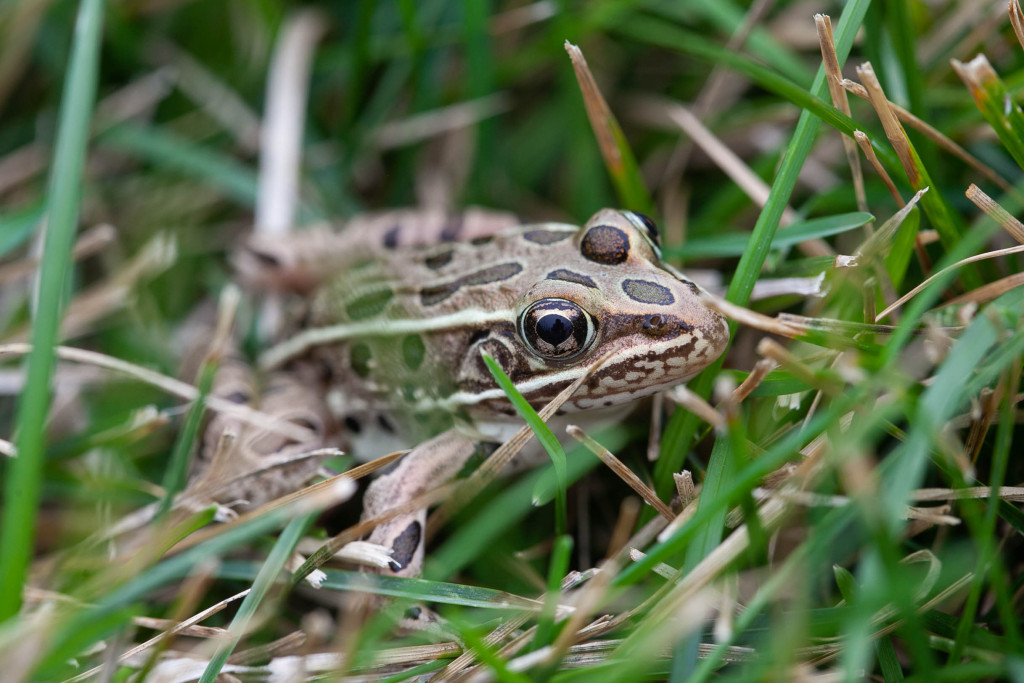
By Olivia DaRugna, Watchable Wildlife Biologist
Spring choruses are in full swing, and while birds may dominate the daytime soundscape, the night is for the frogs and toads. As temperatures warm, frogs and toads emerge after a long, cold winter and begin their annual serenade. Males call out into the darkness, advertising their fitness to females and to defend their territory from nearby males. In Nebraska, there are 11 species of frogs and toads. Four are listed as at-risk of becoming extinct in the state, including the northern leopard frog (Lithobates pipiens), American toad (Anaxyrus americanus), Blanchard’s cricket frog (Acris blanchardi) and western narrow-mouthed toad (Gastrophryne olivacea). This month, our at-risk species spotlight is on the northern leopard frog.
Northern leopard frogs range from the northern half of the United States all the way into Canada. Although they are widely dispersed, their populations have declined throughout their range. Thus, they are listed as critically imperiled or vulnerable of becoming endangered in many western states and Canada. Threats to this species vary across its range and include habitat loss and degradation, as well as competition or predation by introduced species, such as the bullfrog. Here in Nebraska, they are a Tier II Species of Greatest Conservation Need, listed as state vulnerable in the Nebraska Natural Legacy Project.
Northern leopard frogs occur in the northern two thirds of Nebraska. Colleen Rothe-Groleau, a Natural Heritage biologist said, “Northern leopard frog populations are moving northward as the climate warms because they are more adapted to a cooler, wetter climate.”
These frogs typically occur in areas with semi-permanent bodies of water that do not freeze solid in winter and are adjacent to upland habitat. In summer, they commonly inhabit the nearby upland habitat, wet meadows, fields and wet, grassy areas around cattle stock tanks where they forage for small invertebrates.
“Sixty years ago, all leopard frogs in Nebraska were considered subspecies of northern leopard frogs,” Rothe-Groleau explained. “With the advancement of genetic technology, subspecies were elevated to full species, splitting the state at the Platte River with northern leopard frogs to the north and plains leopard frogs to the south and east.”
The plains leopard frogs (Lithobates blairi) are more adapted to the arid prairie environments and typically occur a few kilometers away from water.
he northern leopard frog gets its name from the uniquely shaped dark spots down their backs and legs. Look closely and you’ll see the light halo or border around the spots. Typically, this species is green or brown with two lightly colored, prominent lines (dorsolateral fold) that are continuous from the head to the rear of the body. The similar-looking Plains leopard frog is typically brown and has a distinct white spot on its tympanum, a circular membrane used for hearing located behind the eyes. The dark spots on the Plains leopard frog do not have the light outline, and the prominent lines have a break near the rear legs.
In areas where the Plains and northern leopard frogs overlap, hybridization can occur. Rothe-Groleau says the hybrids typically have identifying traits from both the northern and Plains leopard frogs. For example, a single frog might have a complete dorsolateral fold and no spot on the tympanum like the northern leopard frog on one side of the body, but a broken dorsolateral fold and white spot on the tympanum like the plains leopard frog on the other side of the body.
Tips for Observation
April is a great to time to look and listen for northern leopard frogs. As water temperatures warm to about 50 degrees Fahrenheit, breeding peaks — just make sure to visit suitable habitats in your search for the northern leopard frog. Even if you don’t live near the frog’s range or habitats, you can still search for other frogs and toads. A helpful resource for identifying frogs and toads is A Field Guide to the Amphibians and Reptiles of Nebraska by Daniel D. Fogell.
earching for frogs and toads is best done at night, but you don’t need to use your eyesight to find them – just listen! Different species make different vocalizations. Learning the different frog and toad calls is fairly easy with numerous audio recordings found online, and with just a little practice, identifying species can be a fun spring activity for the family. Listen for the snore-like call of the northern leopard frog that is often followed by a series of croaks or chuckles. Some describe the sound as rubbing your hand over a balloon.
If you’d rather not be out at night, don’t worry! You can still look for frogs, toads and egg masses during the day at many of our diverse wetland habitats across the state.
If you see or hear the northern leopard frog or other at-risk frog or toad species, take a photo or get a sound recording and report it to the Natural Heritage Program using the rare animal survey form. These observations help biologists track the distribution and occurrence of species.
Make an impact in the conservation efforts of at-risk species, like the northern leopard frog, by donating to the Nebraska Wildlife Conservation Fund.
